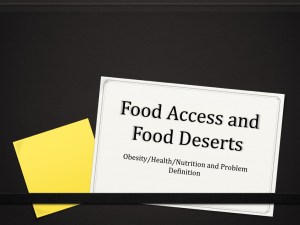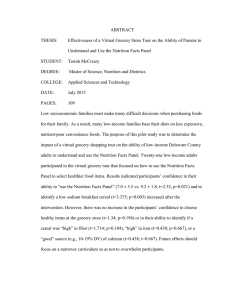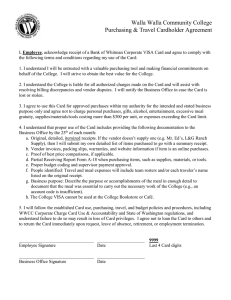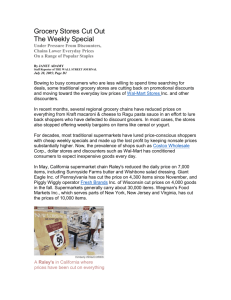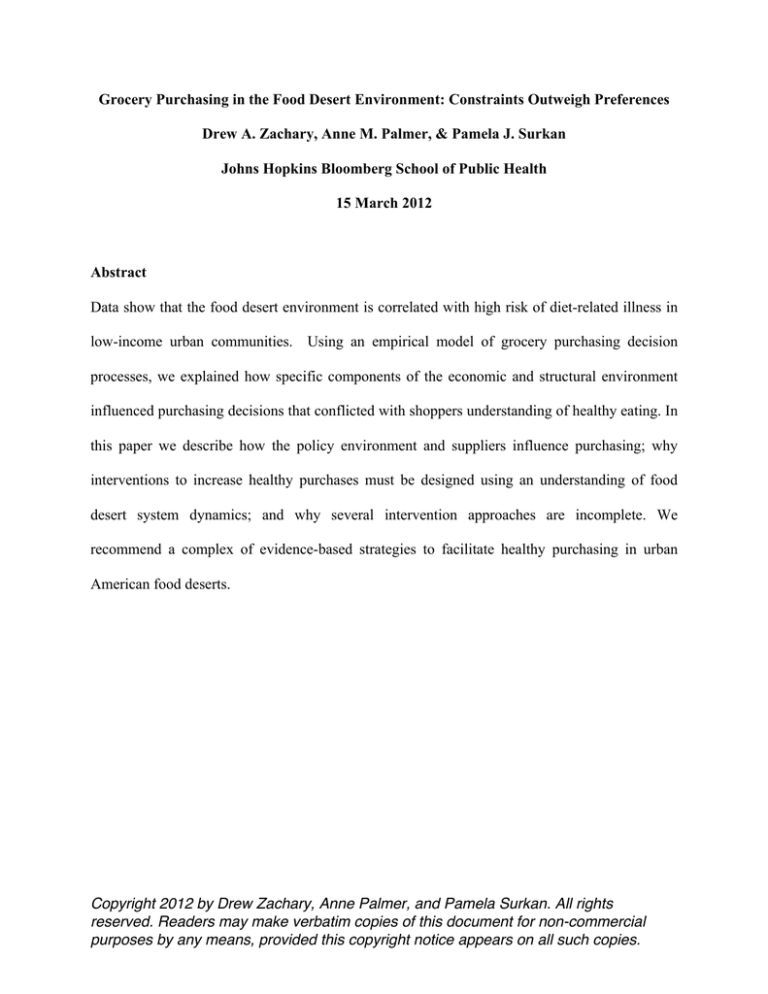
Grocery Purchasing in the Food Desert Environment: Constraints Outweigh Preferences
Drew A. Zachary, Anne M. Palmer, & Pamela J. Surkan
Johns Hopkins Bloomberg School of Public Health
15 March 2012
Abstract
Data show that the food desert environment is correlated with high risk of diet-related illness in
low-income urban communities. Using an empirical model of grocery purchasing decision
processes, we explained how specific components of the economic and structural environment
influenced purchasing decisions that conflicted with shoppers understanding of healthy eating. In
this paper we describe how the policy environment and suppliers influence purchasing; why
interventions to increase healthy purchases must be designed using an understanding of food
desert system dynamics; and why several intervention approaches are incomplete. We
recommend a complex of evidence-based strategies to facilitate healthy purchasing in urban
American food deserts.
Copyright 2012 by Drew Zachary, Anne Palmer, and Pamela Surkan. All rights
reserved. Readers may make verbatim copies of this document for non-commercial
purposes by any means, provided this copyright notice appears on all such copies. Introduction/background
Food deserts in urban and rural American communities are characterized by limited access to full
service supermarkets. Research demonstrates that the food desert environment limits shoppers’
ability to attain healthy eating behaviors, and is associated with the high incidence of diet-related
illnesses such as obesity, heart disease, and type II diabetes in low-income urban communities
(Franco, Diez Roux, Glass, Caballero, & Brancati, 2008; LaVeist, Pollack, Thorpe, Fesahazion,
& Gaskin, 2011; Moore & Diez Roux 2006; Moore, Diez Roux, Nettleton, & Jacobs, 2008;
Treuhaft & Karpyn, 2010; Powell, Slater, Mirtcheva, Bao, & Chaloupka, 2007). Research has
focused on macro-level analyses describing the structural environment and the actors in food
deserts. Emerging micro-level research has identified general shopping strategies used by
consumers in food deserts in an attempt to better understand the dynamics within food deserts,
and to inform behavioral and policy interventions (Clifton, 2004; Rose, 2011; Zenk et al., 2011).
The authors of the current paper have recently provided a detailed analysis of the underlying
decision process, seeking to explain how the food desert environment affects individual
purchasing behavior, outcomes, and ultimately health in low-income communities (Zachary,
Palmer, Beckham, & Surkan, 2012, summarized below). Using qualitative data on grocerypurchasing decisions in the context of a specific supermarket, our recent article presented a
model of food purchasing decision processes used by low-income shoppers in an urban
American food desert. We analyzed the role supermarket characteristics and other environment
qualities play in determining grocery purchases and how they affect consumers’ ability to
purchase healthy foods.
2 The paper builds on the prior model, with the objectives of: (1) explaining how the policy
environment and other actors affect the shopping decisions; (2) explaining implications for
policy and current approaches to intervention; and (3) applying our previous findings to identify
a complex of evidence-based policy interventions that target various environmental influences on
consumers’ grocery purchasing.
Methods
Data
Analysis for this study is based on verbal qualitative data (37 semi-structured in-depth
interviews, n=31; 3 focus groups, n=22) and data from direct/participant observation at a
supermarket in a low-income urban community. The semi-structured in-depth interviews
provided data on consumers’ perceptions of the community and immediate supermarket
environment, their perceptions of healthy and unhealthy eating, and how they make decisions
about grocery purchasing. Focus groups were used to identify shared perceptions, decision
criteria, and shopping strategies, and consumers’ ideas about how to modify the environment to
increase healthy purchases.
Observation provided data on the structural qualities of the
supermarket environment, including the layout, displays, signage, pricing, food quality and
selection; grocery shopping behavior in the context of the supermarket environment; and
common purchases.
Study Setting and Participants
Study participants were low-income, predominantly African-American women, who had
children age 15 or under in the household and were the primary food purchasers for their
3 households. The sample participants varied according to economic-resource level and available
transportation, but most did not have access to a car. The majority of participants received some
federal food assistance from the Women, Infants, and Children (WIC) program and/or
Supplemental Nutritional Assistance Program (SNAP, commonly known as Food Stamps).
Some participants lived walking distance from the study supermarket while others were ten to
fifteen minute driving distance by car. Participants who did not have access to cars traveled to
the supermarket by foot, bus, informal taxi, or some combination.
The study supermarket is the only full-service supermarket in the study community.1 The owner
refers to it as a “price impact store” (Personal communication, study supermarket owner, March
1, 2012). The shoppers all mentioned the sales, prices, location, and convenience as reasons to
shop there. Several mentioned that it “caters to the [low-income] area.”
Analysis
A decision-analytic approach, informed by situated cognition theory, was used to integrate the
widely shared elements of individual decision processes into a single model of decisions about
food purchases. The model explains how attributes of the household, economic constraints, and
qualities of the supermarket environment lead to observed purchasing behavior, and explains the
environmental context of unhealthy purchases. The current analysis builds on our previous
model by outlining policy implications of shared purchasing strategies. We present a complex of
evidence-based policies intended to modify the grocery purchasing decision environment, and
thus help consumers in food deserts make healthy purchases.
1 All
participants shopped at the study supermarket, but some participants also traveled outside the community to
other supermarkets when possible. 4 Findings from this study are based on data on grocery purchasing among families in one
particular urban community. However, the results are consistent with results from other studies
in the emerging literature on food acquisition in urban food deserts, using broader study
populations in other American cities (Clifton, 2004; Rose, 2011; Zenk, et al., 2011). The
findings are also supported in the literature on situated action and how behavior results from an
interaction between people and their environments (Gero, 2011; Henning 2000; Suchman, 1987).
Results: How Environmental Context Affects Grocery Purchases
Consumers’ grocery purchasing decisions depend on the environment
Shoppers in our sample were systematically unable to exercise their preferences for healthy,
fresh, and natural foods – this contributed to negative health outcomes. We found that food
purchases in the study population primarily reflected qualities of the decision environment rather
than healthy eating preferences. Shoppers’ interaction with their environment – including
economic and physical resources in the broadly defined environment and the immediate
supermarkets accessible to them – led to purchases that were unhealthy and that did not reflect
what they would prefer without constraints.
The availability of physical and economic resources affects how shoppers think about the cost of
certain products and thus how they allocate their grocery budgets. As a result, grocerypurchasing decisions must be understood as they relate to the food desert environment. Due to
limited budgets and the need to consistently provide sufficient food for the household, all
grocery decisions were planned using a complex rational decision process, which determined
5 economically feasible purchases.2
Given the knowledge of their resource constraints and the environment available to them,
participants used decision criteria that incorporated their estimation of factors other than the label
price.
•
Travel and time cost associated with purchasing the product: Products unavailable at the
closest supermarket required additional costs in terms of travel and time. Since perishable
products have a limited shelf life, purchasing fresh food requires frequent shopping trips,
which requires additional time and transportation expense. Therefore frozen and canned
options had lower transaction cost, as they were cheaper, longer lasting, and carried limited
risk of spoiling.
•
Risk of wasting food/money: There is cost associated with the risk of throwing away
food/money. This applied to low quality fresh foods (e.g., fruit/vegetables) that might spoil
before they could be used and to unfamiliar or new foods that children and other household
members might not eat. Shoppers frequently estimated the amount that would actually be
used, and incorporated that into the perceived cost of the product.
•
Cost-effectiveness compared to other products: Aside from the absolute price, shoppers
considered meals provided per dollar. Calorie-dense, filling products better sustain the
household at a lower cost. Shoppers would have to buy a higher volume of healthier foods
and spend more to provide the same number of meals.
Participants demonstrated context-dependent decision criteria for choosing purchases that would
2 See
Zachary, Palmer, Beckham, & Surkan, (2012) for full description of these results and the decision
process used, and how situated cognition theory applies to consumers’ grocery purchasing.
6 provide for the household without wasting food or money. We identified empirical heuristics
rule, which participants used to combine these decision criteria to make best use of the resources
in their environment. (See Kahneman & Frederick, 2002; Simon, 1996) Shoppers used the
criteria in combination, and estimated tradeoffs based on specific resources such as access to a
car. Shopping locations and products were selected using these heuristics in attempt to:
•
Optimize use of sales– comparing prices using circulars, and buying sale products during
each shopping trip;
•
Minimize transportation time and cost (e.g. by choosing products with a long shelf-life);
and
•
Maximize quantity and quality of product per dollar spent in order to provide the greatest
number of meals per dollar.
In making these decisions shoppers used the physical supermarket environment – including
layout, design, quality, and available selection. Thus the physical environment was an important
context for consumers’ decisions. Consumers used sale signs and advertisements to identify costeffective purchases. They also reacted to the perceived quality of foods on a particular shopping
trip by avoiding fresh or new products if they had concern they would not be able to use the
foods before they would spoil. These findings are consistent with evidence that the immediate
physical environment affects behavior, and that people use their environments to “achieve
intelligent action” (Suchman, 1987, cited by Henning, 2000; Wilson, 2002).
The policy environment
Supplemental Nutrition Assistance Program (SNAP) policies influenced grocery-purchasing
7 decisions. In the study State, SNAP benefits are transferred to recipients once per month in
alphabetical order, with the first transfers on the 6th and the last on the 15th. Shoppers had
limited budgets for groceries, often most or all from SNAP benefits, and thus benefit schedules,
shopping frequency, and consumers’ purchases were interrelated. With limited transportation
resources and few available supermarkets, traveling to the market was expensive for many
participants, in terms of both time and travel cost. As described above, given the relative cost of
foods, and low quality of perishable foods at available supermarkets, grocery purchases were
largely non-perishable items. In the context of all these factors – type of food purchased, travel
cost, and timing of resource availability – shoppers often made one main grocery trip per month
which coincided with SNAP benefits release.3
The relationship between SNAP policy design and purchasing is important for interventions.
Interventions should be designed with the understanding that it is expensive to shop frequently –
this affects not only when people shop, but also what foods they purchase, and specifically their
ability to purchase perishable foods. Moreover, this pattern illustrates the interrelated nature of
factors of the individual resource, community, and environments that work together to influence
consumer behavior.
SNAP’s effect on purchasing also illustrates that, unlike WIC, SNAP is not a nutrition program.
Both SNAP and WIC provide financial resources (vouchers) for food, but because WIC is
specific to child and maternal health/nutrition, it is designed to maximize nutritional quality.4 (U.
S. Department of Agriculture, 2012, “SNAP”). WIC voucher use is intended for specific healthy
3
In some cases budgets were so limited that many participants could not afford to buy all the food they
planned and had to prioritize at the check out.
4
The program has consultation and information components.
8 products including milk and produce. SNAP beneficiaries have no explicitly nutrition-related
restrictions on the types of food purchased (although SNAP does restrict use, e.g. hot foods are
not covered). (U.S. Department of Agriculture, 2012, “About WIC”)
Participants receiving WIC often explained that the program facilitates healthy purchases. WICapproved products such as wheat bread and whole grain cereals are identified with special
labeling in the supermarket, providing an additional visual cue in the immediate shopping
environment. Thus, WIC provides beneficiaries two benefits in the grocery purchasing decision
process – financial incentive/support for healthy products assists in planning affordable
purchases, and WIC labeling in the supermarket identifies healthy products in the immediate
environment.
Conflicting perspectives on the environment
Our research revealed discrepancies between how key actors in the behavioral system perceive
qualities of the supermarket environment (see discussion of food deserts as behavioral systems
below; see also Simon [1996] and Wilson [2002]). For example, we found that consumers and
suppliers had conflicting views on pricing as it relates to food stamps. The days on which
benefits are transferred are extremely crowded at supermarkets with high SNAP usage. We
found that the supermarket owner and managers believed they had to lower food prices after
food stamps are issued, because food does not sell toward the end of the month. Shoppers, who
observe lower prices after food stamps time is over, perceive this as the prices being “jacked up
when [the supermarket managers] know food stamps are out,” which they feel takes advantage of
their economic constraints.
9 While this discrepancy itself did not necessarily affect shoppers’ ability to purchase healthy
foods, it is part of their shopping decision environment. It is representative of many differences
between consumers’ and suppliers’ perspectives in food deserts. The difference in prices
throughout the month is important because pricing has a significant effect on purchasing in the
food desert environment – participants explained that they compare prices across stores and buy
products when are where they are on sale. Shoppers have relatively more purchasing power
when the prices are lower, which also allows more healthy purchases. This dynamic also
illustrates how the SNAP schedule affects suppliers – creating high traffic during one part of the
month, and little business at other times. We found that the study supermarket management made assumptions about why customers made
certain purchases, and while they observed the behavior they expected, their assumptions about
their shoppers’ intentions or decision rationales were not accurate. For example, when the store
stocked organic and all-natural meats, they did not sell; the store management assumed this was
because shoppers were not interested in healthy eating. However, the shoppers explained that
healthier products such as natural/preservative-free meat are more desirable, but they are simply
unaffordable – a key informant in a walk through interview pointed out it is twice as expensive
as conventional meat.
Research also revealed differences in how the shoppers and management perceive the
supermarket layout. Shoppers consistently complained about the unhealthy “junk” that appears
immediately at the single entrance to the supermarket. However, supermarket managers insisted
10 that on entering the store the first thing a person would see is the fruits and vegetables section.
While the produce section is located near the entrance, it competes with other displays in the
immediate area including large islands and walls stacked with high-sugar juice drinks, cereals,
and snacks. Products such as fruit snacks and desserts are placed directly next to fresh fruit
displays. (See Zachary et al., [2012] for additional description of and participant reactions to the
supermarket layout).
Upon entering the store, the first products encountered were unhealthy items, often marketed
towards children. Shoppers responded to the displays based on their shopping decision criteria –
products were on sale and perceived as cost-effective. Participants believed that with this layout,
there was no way to avoid unhealthy products, and that placing healthier products in the front
area would increase healthy purchases. Conversely, the supermarket managers and owners, who
designed the shopping environment, believed not only that fruits and vegetables were the most
prominent displays at the store entrance, but also that unhealthy product displays could be
avoided based on personal will and preferences.
This discrepancy potentially inhibits an
intervention to increase healthy purchasing.
Policy implications
Food deserts as behavioral systems
Our research demonstrates that food deserts can best be understood as behavioral systems.
Individual behavior occurs in environmental context, and depends on other actors, policies,
physical resources, and other qualities of the broadly defined and immediate environments.
11 Although grocery shopping in food deserts is highly context dependent, there is evidence
(Clifton, 2004; Palmer, Smith, Haering, & McKenzie, 2007; Rose, 2011; Zenk et al., 2011) that
many urban food deserts demonstrate similar qualities in terms of:
•
Individual shopping strategies;
•
Qualities of the physical and socioeconomic environments;
•
The influence of transportation on food shopping;
•
Over-marketing and abundance of unhealthy products at available supermarkets; and
•
Crowding and higher prices at local supermarkets during food stamp benefits release.
Prior researchers have argued that multifaceted intervention strategies must be used to improve
health in food deserts, and specifically in low-income, predominantly minority communities
(Bell & Standish 2005; LaVeist et al. 2011; Woolf & Braverman, 2011). Our data support the
argument that in order to generate individual-level change in communities, policies must include
reforms at multiple levels, including national policy, industry regulation and incentives, city
policy, and individual store initiatives, reflecting the broad spectrum of environmental influences
on purchasing.5 Rather than targeting one component of a complex behavioral system (i.e.
individual or structural), effective policies must act on multiple factors simultaneously, and
ideally in coordination with each other. Moreover, policy can best – and perhaps can only –
modify food deserts, or the individual outcomes in them, if interventions are designed based on
an understanding of dynamics within the system.
Informing intervention strategies
We expand on prior recommendations for multifaceted interventions by connecting an empirical
5
Clifton, 2004; Rose, 2011; Zenk, et al., 2011, drew similar conclusions based on their data.
12 understanding of food desert dynamics to specific policy recommendations. Our findings suggest
that it is particularly important for policy interventions to make healthy purchases compatible
with households’ needs to provide sufficient food on a limited income.
SNAP policy design is a potential intervention point to facilitate healthy purchases. SNAP
benefits constitute a large portion of many households’ food budgets, and there is strong
empirical evidence in our data that purchasing patterns are coordinated with SNAP design (see
also: Rose, 2011). Given the significant overlap between SNAP participation, individual
decision factors, and diet-related illness in low-income communities, SNAP has the potential to
be an effective nutrition-oriented program (cf. Monsivais, Aggarwal, & Drewnowski [2011]).
Enhanced understanding of current intervention strategies
An empirical understanding of purchasing behavior in food deserts suggests that certain
approaches to intervention – currently implemented or as suggested in current literature – might
be ineffective. Several examples are discussed below.
Information
Prior studies have recommended increasing information and motivation to increase healthy
eating in food deserts (e.g., Chang, Nitzke, Guilford, Adair, & Hazard, 2008; Eikenberry &
Smith, 2004). There is evidence that interventions or policies focused on information will be
incomplete if taken in isolation. Research demonstrates that many residents of low-income
communities understand and value healthy eating, but other factors have a stronger bearing on
their purchasing decisions (e.g. buying cost-effective non-perishable food, getting the best price
13 per number of meals provided). Even if education efforts increase or expand knowledge of
healthy eating, data suggest knowledge of, and preference for, buying foods that shoppers
consider healthy is not a primary influence on grocery purchases in food deserts. Moreover,
information does not have a uniform effect on behavior. Since many shoppers already want to
eat in a healthy way, increasing information/motivation is not necessarily well matched to their
stages in the adoption cycle (Achterberg & Miller, 2004).
Focus on produce/fresh food
Prior recommendations for increasing healthy purchasing involve promoting fresh fruits and
vegetables (e.g. Glanz & Yaroch, 2004), or increasing the number of local outlets that carry fresh
produce. Interventions strategies focused only on fresh produce or fruits and vegetables (e.g.,
Baltimore Food Policy Initiative) have limitations. The approach of increasing access to fresh
food assumes that if people had more local opportunities to purchase fresh produce they would
do so. However, we found that interventions would also need to address issues of
freshness/quality, because low quality or risk of spoiling was cited as a reason not to purchase
fresh produce.
Fresh food is not affordable for some shoppers because of factors including transportation,
time/travel, and cost. Although expanded access might address these issues, purchases are often
planned in the context of monthly resources; access to fresh food would not change the
opportunity cost of buying fresh (i.e. a larger volume of non-perishable food). We also found
that shoppers already buy produce, and produce usually does not constitute the majority of a
person’s diet. These strategies should incorporate efforts to promote organic and additive-free
14 canned and frozen alternatives to fresh produce; however they have limited ability to address
relatively inexpensive, processed foods.
Access
Interventions calling for increased access to food or an increased number of supermarkets in
urban food deserts (Raja, Ma, & Yadav, 2008; Treuhaft & Karpyn, 2010) over simplify the
background of grocery purchasing behavior. Focusing broadly on access does not necessarily
acknowledge the economic context of purchasing decisions or the fact that people have learned
to think about grocery shopping in the food desert environment (i.e. the activity is situated in the
environment).
Solely increasing the presence of grocery stores will not necessarily change purchasing behavior.
There also needs to be an effort to create a supermarket environment that supports healthy
purchases, opportunities for sampling new foods, sales on healthy foods, identification of healthy
foods, etc, thus reducing the “risk cost” of buying fresh foods. Increasing the number of local
supermarkets in food deserts is also important because it decreases the time cost of buying
perishable foods, and potentially allows people to shop more frequently by reducing the travel
and time cost of trips.
Supermarket or corner store interventions
While supermarket or corner store public health interventions6 have some ability to modify the
immediate environment and thus influence purchases through signage, labeling, information,
6
Larger scale models include the Fresh Food Financing Initiative; the Healthy Corner Store Network; Baltimore
Healthy Carryouts.
15 they have limitations. These interventions must be accompanied by industry-level and policy
remedies, because individual stores and distributors have limited ability to change prices and
marketing practices. For example, in the supermarket intervention based on this research, we
were unable to change some components of the immediate environment because the store has
distributor agreements regarding placement. Moreover, store approaches do not address the
broad context of the supermarket environment, which includes transportation, available income
for shopping, and the relative price of healthy foods.
Cost
Prior studies found that the high cost of healthy foods inhibited healthy eating, and calls for
reducing the cost of healthy food to increase healthy purchases (Cassady, Jetter, & Culp, 2007;
Fulp, McManus, & Johnson, 2008; Monsivais, Aggarwal, & Drewnowski, 2011). This
recommendation is important but often does not provide enough information about the
background of purchasing decisions. Based on our findings, simply giving low-income shoppers
more money to spend on food would not necessarily change which foods they purchase. For
example, when we asked people what they would do with a larger budget for food, some
explained they would buy more of everything they currently buy. This is explained by the
argument that cognition on the whole is environmentally situated (Suchman, 1987). Similarly,
shoppers will not necessarily respond to the reduction in price of certain healthy foods (that they
previously considered unaffordable), unaccompanied by other interventions. Prices of healthy
foods should be reduced, but in developing price reduction strategies it is important to consider
which foods consumers consider too expensive, and what factors other than label price can
increase the perceived cost of a product, including risk of wasting food, travel cost, perishability
16 cost, and relative cost (i.e. opportunity cost). Policy Recommendations
There is evidence in our data and the existing empirical research on food deserts that many
components of the environment would have to change to influence consumer purchasing. Data
point to a complex of policies that are grounded in holistic empirical analysis and are more likely
to effectively address the factors that influence food acquisition in food deserts. Table 1 presents
the design features a multi-faceted, evidence-based policy intervention would incorporate to
increase healthy purchases in urban American food desert environments. For each intervention,
the table describes the empirical rationale, the level or point at which the intervention would be
implemented, and political or logistical considerations.
[TABLE 1 HERE]
Conclusion
Shoppers’ understanding of and approach to grocery shopping starts with planning in the context
of the broad environment. Thus interventions intended to change behavior should aim to change
the context of food purchasing and the way people think about and do grocery shopping. Many
current strategies for improving food desert environments, or consumer behavior in food deserts,
target important – but only limited – components of food purchasing. Taken alone they are not
sufficient to change individual behavior that is strongly rooted in environmental context.
An empirical understanding of food desert dynamics supports the view that system-oriented and
17 multifaceted national policy solutions are necessary. Comprehensive strategies should include as
much change to the environment as possible. This requires a complex of policies, grounded in an
empirical understanding of the food desert system (as described in Table 1). Ideally all
components would be implemented together, but this coordination is structurally difficult and
will take time. Multi-faceted, cross-disciplinary approaches are logistically and politically
challenging given the current organization and operation of government, but they are more likely
to be effective.
A strength of this analysis is that it is based on an empirical understanding of behavior in a
specific food desert context, from the perspective of actors in the environment. The analytical
framework applied captures the complexity of behavior and the interaction between individuals
and their environment (Garfinkel 1967; Gero, 2011; Suchman, 1987). The research, however,
was a case study and is not necessarily representative of all urban American food deserts. Our
goal was to provide an in-depth, contextual understanding of the case. While it was not the
objective of the research to generalize beyond the study community, case studies can teach
generalizable lessons – for example, by providing evidence against absolute hypotheses
(Flyvbjerg, 2006). This is important because policies or policy recommendations are implicitly
or explicitly based on absolute assumptions about how people/behavior will respond to an
intervention. Behavioral assumptions also affect the way the public frames target populations
(Cummins & Macintyre, 2002; Rigby, Soss, Booske, Rohan, & Robert, 2009). Our results
demonstrate that in at least one city, assumptions and the policies they influence are flawed.
There is even stronger evidence of this point given consistent findings across studies, as
described above, but other research replicating decision analysis methods would help clarify the
18 generality of these findings.
Additional context-specific research is needed at a national level, especially in other urban food
desert communities. Further research should also explore how policy remedies related to diet
and health can be integrated with – or how they overlap with – policies to address other problems
in low-income urban communities, such as employment and crime.
19 Table 1. Complex of evidence-based strategies to increase healthy grocery purchasing in
urban American food deserts
INTERVENTION
RATIONALE
INTERVENTION
POINT/
APPROACH
POLITICAL/ LOGISTICAL
FEASIBILITY
Provide relatively more
purchasing power to spend on
(healthy) food; reduce prices of
healthy products
Reduce relative price of
healthy foods (substitution
effect)
National level, SNAP
and WIC policy design,
industry
incentives/subsidies
Expensive, feasible on a pilot
basis; Potential benefits to
health food suppliers
Increase availability of bulk
and/or non-perishable healthy
foods (e.g., frozen organic
produce, no preservative added,
low-sodium packed/dried food)
Reduce the cost of organic, unprocessed, nutrient-dense, and
reduced fat/
calorie/sodium/sugar foods
Allows people to buy
healthy foods when they
cannot shop frequently
National-level subsidies
or incentives for
industries
Requires cooperation from
industry for
marketing/distribution
practices
Changes the relative price
of healthier alternatives,
Addresses the concern that
the same product could be
purchased for less
Reduce the opportunity
cost of buying fresh
produce by reducing travel
cost
National, Regulatory,
Industry
Difficult to achieve at store
level without
manufacturers/suppliers
reducing their prices; added
cost of organic certification
Popular belief that there
would not be demand;
Increased demand for fresh
food suppliers
Increase the number of local
outlets to buy fresh food (e.g.,
corner stores, farm stands, food
trucks, farmers markets) in lowincome urban neighborhoods
Increase the total number of
accessible supermarkets
Reduce the opportunity
cost of buying perishable
foods by reducing travel
cost
Offer free transportation to food
outlets in low-income areas (e.g.
a circulator)
Reduce the opportunity
cost of buying perishable
foods by reducing travel
cost
Higher quality and
freshness of produce
reduces risk of wasting
food, reducing the
perceived cost of buying
fresh produce
Eliminate added visual cue
to purchase unhealthy, but
typically cost-effective
products
Give shoppers in all
environments equal
information to make
healthy purchasing
decisions
Improve buying and stocking
practices for produce in lowincome urban markets; monthly
schedule in areas with high
SNAP participation
Reduce the promotion of
processed, unhealthy foods
(placement, signage, advertising
to children)
Increase information about what
is and isn’t healthy
City-level programs (e.g.
Baltimore Food Policy
Initiative), National-level
private sector
incentive/subsidy (e.g.
tax credits, grants,
loans7)
National-level private
sector incentive/subsidy
(e.g. tax credits, grants,
loans)
State or City level
Regulatory;
Wholesaler or city level
Requires time to locate a
store, collaboration between
sectors for financing; High
cost;
Potential spillover benefits
Competition for limited city
resources;
Potential spillover effects
(job creation)
Difficult enforcement,
compliance checks;
Location-dependent freshness
Regulatory;
Industry level
Opposition to interference in
industry marketing practices
Regulatory; Store-level;
expand reach through
implementation at chain
markets
Potential opposition from
producers;
Added cost of requiring
addition signage, labeling
7 As used in the Pennsylvania Fresh Food Financing Initiative, Healthy Corner Store Network 20 References:
Achterberg, C. & Miller, C. (2004). Is one theory better than another in nutrition education? A
Viewpoint: more is better. Journal of Nutrition Education and Behavior, 36: 40-42
Bell, J. & Standish, M. (2005). Communities and health policy: A pathway for change. Health
Affairs, 24:2, 339-342
Cassady, D., Jetter, K. M., & Culp, J. (2007). Is price a barrier to eating more fruits and
vegetables for low-income families? Journal of the American Dietetic Association,
107(11), 1909-1915. doi: 10.1016/j.jada.2007.08.015
Chang, M. W., Nitzke, S., Guilford, E., Adair, C. H., & Hazard, D. L. (2008). Motivators and
barriers to healthful eating and physical activity among low-income overweight and
obese mothers. Journal of the American Dietetic Assoc, 108(6), 1023-1028.
doi:10.1016/j.jada.2008.03.004
Clifton, K. J. (2004). Mobility strategies and food shopping for low-income families: A case
study. Journal of Planning Education and Research, 23(4), 402-413.
doi: 10.1177/0739456X04264919
Cummins, S. & Macintyre, S. (2002). “Food deserts”—evidence and assumption in health policy
making. British Medical Journal, 325(7361): 436-438.
Eikenberry, N., & Smith, C. (2004). Healthful eating: Perceptions, motivations, barriers, and
promoters in low-income Minnesota communities. Journal of the American Dietetic
Association, 104(7), 1158-1161. doi: 10.1016/j.jada.2004.04.023
Flyvbjerg, B. (2006). Five misunderstandings about case-study research. Qualitative Inquiry,
12(2), 219-245.
Franco, M., Diez Roux, A. V., Glass, T. A., Caballero, B., and Brancati, F.L. (2008).
21 Neighborhood characteristics and availability of healthy foods in Baltimore. American
Journal of Preventive Medicine, 35: 561-567.
Fulp, R. S., McManus, K. D., & Johnson, P. A. (2009). Barriers to purchasing foods for a highquality, healthy diet in a low-income African American community. Family &
Community Health. 32(3), 206-217. doi: 10.1097/FCH.0b013e3181ab3b1d
Garfinkel, H. (1967). Studies in ethnomethodology. Englewood-Cliffs, NJ: Prentice Hall.
Gero, J. S. (2011). A situated cognition view of innovation with implications for innovation
policy. In K. Husbands-Fealing, J. Lane, J. Marburger, S. Shipp, & B. Valdez (Eds.), The
science of science policy: A handbook (pp. 104-119). Palo Alto, CA: Stanford University
Press.
Glanz, K., & Yaroch, A. L. (2004). Strategies for increasing fruit and vegetable intake in grocery
stores and communities: Policy, pricing, and environmental change. Preventive Medicine,
39, S75-S80. doi:10.1016/j.ypmed.2004.01.004
Henning, P. H. (2000). Everyday cognition and situated learning. In Learning Vol. 2 (pp. 143168). Hillsdale, NJ: Lawrence Erlbaum. Retrieved from
http://www.aect.org/edtech/06.pdf
Kahneman, D. & Frederick, S. (2002) "Representativeness Revisited: Attribute Substitution in
Intuitive Judgment". In Thomas Gilovich, Dale Griffin, Daniel Kahneman. Heuristics
and Biases: The Psychology of Intuitive Judgment. Cambridge: Cambridge University
Press. pp. 49–81.
LaVeist, T., Pollack, K., Thorpe Jr, R., Fesahazion, R., & Gaskin, D. (2011). Place, not race:
Disparities dissipate in southwest Baltimore when blacks and whites live under similar
conditions. Health Affairs, 30(10), 1880-1887.
22 Monsivais, P., Aggarwal, A., & Drewnowski, A. (2011). Following federal guidelines to increase
nutrient consumption may lead to higher food costs for consumers. Health Affairs, 30(8),
1471-1477. doi:10.1377/hlthaff.2010.1273
Moore, L. V., & Diez Roux, A. V. (2006). Associations of neighborhood characteristics with the
location and type of food stores. American Journal of Public Health, 96(2), 325-331. doi:
10.2105/AJPH.2004.058040
Moore, L. V., Diez Roux, A. V., Nettleton, J. A., & Jacobs, D. R. (2008). Associations of the
local food environment with diet quality—A comparison of assessments based on
surveys and geographic information systems: The multi-ethnic study of atherosclerosis.
American Journal of Epidemiology, 167(8), 917–924. doi: 10.1093/aje/kwm394
Palmer, A., Smith, J., Haering, S. A., & McKenzie, S. (2007). Understanding and addressing
food security in Southwest Baltimore. Unpublished manuscript, Center for a Livable
Future. Retrieved from http://www.jhsph.edu/bin/o/u/OROSWreport2009-1-1.pdf
Powell, L. M., Slater, S., Mirtcheva, D., Bao, Y. & Chaloupka, F. J. (2007). Food store
availability and neighborhood characteristics in the United States. Preventive Medicine,
44(3), 198–195. doi: 10.1016/j.ypmed.2006.08.008
Treuhaft, S., & Karpyn, A. (2010). The grocery gap: Who has access to healthy food and why it
matters. Philadelphia, PA: Policy Link, The Food Trust. Retrieved from
http://www.policylink.org/grocerygap
Raja, S., Ma, C., & Yadav, P. (2008). Beyond food deserts: Measuring and mapping racial
disparities in neighborhood food environments. Journal of Planning Education and
Research, 27(4), 469-482. doi: 10.1177/0739456X08317461
Rigby, E., Soss, J., Booske, B. C., Rohan, A. M. K., & Robert, S. A. (2009). Public responses to
23 health disparities: How group cues influence support for government intervention. Social
Science Quarterly, 90(5), 1321-1340.
Rose, D. J. (2011). Captive audience? Strategies for acquiring food in two Detroit
neighborhoods. Qualitative Health Research, 21(5), 642-651.
doi:10.1177/1049732310387159
Simon, H. A. (1996). The Sciences of the Artificial, 3rd ed., Cambridge, MA: The MIT Press.
Suchman, L. A. (1987). Plans and situated action: The problem of human-machine
communication. New York, NY: Cambridge University Press.
U. S. Department of Agriculture. (2012). About WIC: WIC's Mission, Retrieved from
http://www.fns.usda.gov/wic/aboutwic/mission.htm
U. S. Department of Agriculture. (2012). Supplemental Nutrition Assistance Program: A short
history of SNAP. Retrieved from
http://www.fns.usda.gov/snap/rules/Legislation/about.htm
Wilson, M. (2002). Six views of embodied cognition. Psychonomic Bulletin & Review, 9(4),
625-636. doi: 10.3758/BF03196322
Woolf, S. H., & Braverman, P. (2011). Where health disparities begin: The role of social and
economic determinants—and why current policies may make matters worse. Health
Affairs, 30(10):1852-1859. doi: 10.1377/hlthaff.2011.0685
Zachary, D., Palmer, A., Beckham, S., & Surkan, P. (2012). A Framework for understanding
grocery purchasing in a low-income urban community, Qualitative Health Research, In
press.
Zenk, S. N., Odoms-Young, A. M., Dallas, C., Hardy, E., Watkins, A., Hoskins-Wroten, J., &
Holland, L. (2011). “You have to hunt for the fruits, the vegetables”: Environmental
24 barriers and adaptive strategies to acquire food in a low-income African American
neighborhood. Health Education & Behavior, 38(3), 282-292.
doi:10.1177/1090198110372877
25

